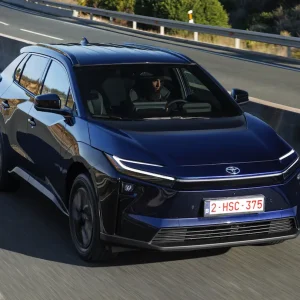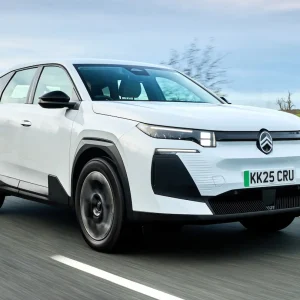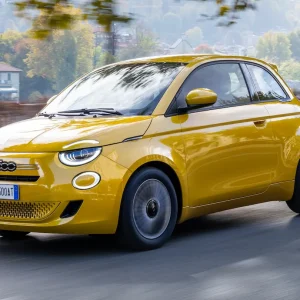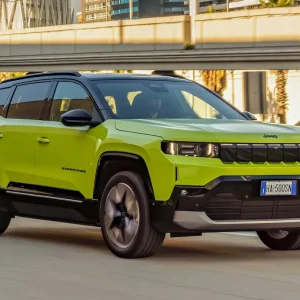
All the attention might be on its curvier sister car, the iX2, as it has only recently been launched in the UK. However, at the same time, the first entry-level eDrive20 versions of the iX1 have also been released – and we’ve been lucky enough to get a drive!
Tasked with opening the iX1 to more fleet drivers, because of its lower entry price, key changes take place under the iX1’s SUV body, as it gets a single motor, rather than the twin-motor xDrive30 that we most recently drove as a long-termer. With the single motor power drops to 202hp, from the xDrive30’s 313hp. As such, the newcomer is also slightly slower, reaching 62mph in 8.6 seconds, compared to the xDrive30’s time of 5.6 seconds. To be honest, on the road you hardly notice this power reduction of the eDrive20, as the overly light, but responsive steering and engaging handling are unchanged. It is, in our opinion, better.
The lack of a second motor gives the iX1 eDrive20 a lighter, more engaging feel to the drive. Like our previous xDrive30, this M Sport-spec test car was on 19in alloy wheels, which rode confidently and compliantly.
The biggest change for the eDrive20 over the xDrive30 is the increase in range, from 268 miles to 296 miles, which seemed reasonably accurate on our drive. Plus, the eDrive 20 can be charged at up to 130kW, meaning a 10-80% charge takes just 29 minutes.
Outside, the iX1 remains an attractive car, and the only obvious change is the shark nose design of the sealed front kidney grilles – like the iX2. Plus, on our car, an optional set of 19in bi-colour alloy wheels. Then there’s the subtle eDrive20 badging, which is the only way to tell it apart from a similar eDrive40 version.
Inside, the same new textured interior trim as the iX2 was the only obvious change we could spot. Sitting on the UKL platform, we continue to be impressed by the iX1’s longer wheelbase. So, think longer and taller than you would expect. In fact, the iX1’s interior feels almost as roomy as an SUV from the class above. This equals a comfortable, multi-adjustable driving position, that continues to please even the tallest drivers. Legroom is equally impressive in the back of the iX1. The battery pack under the floor means the 40:20:40 split/fold rear seat doesn’t slide as it does in the ICE-powered car – it’s also mounted higher, so taller passengers might struggle to get comfortable in the back. Boot space also drops from 540 litres to a still decent 490 litres.
The infotainment runs BMW’s latest OS8 software, and is very logical and easy to use, although the presence of physical controls is sadly missed. In fact, we’d recommend using the voice control system – which doesn’t always work – otherwise your screen will be continually covered in fingerprints. Elsewhere, there’s the same space-efficient floating centre console, housing the gear selection buttons.
We were told that for early corporate demand, the iX1 eDrive20 is expected to be the core model, with demand split between the new entry-level Sport model and the M Sport that we’re driving here. The Sport is still an attractive proposition for fleet, with all the key equipment covered, and a more affordable £46,205 starting price. Although if the budget
can be stretched to the M Sport, all bases are really covered in terms of the equipment and finish.
Whatever iX1 eDrive20 you choose, there seem to be few compromises other than power. In our opinion, it strengthens the iX1’s position as our favourite premium medium SUV.
BMW iX1 eDrive20 M Sport
P11D: £50,900
Residual value: 39%
Depreciation: £30,525
Fuel: £3,801
Service, maintenance and repair: £1,967
Cost per mile: 60.48p
Range: 296 miles
CO2 (BIK %): 0g/km (2%)
BIK 20/40% a month: £16/£33
Luggage capacity: 490 litres
Battery size/power: 64.7kWh/ 202hp





